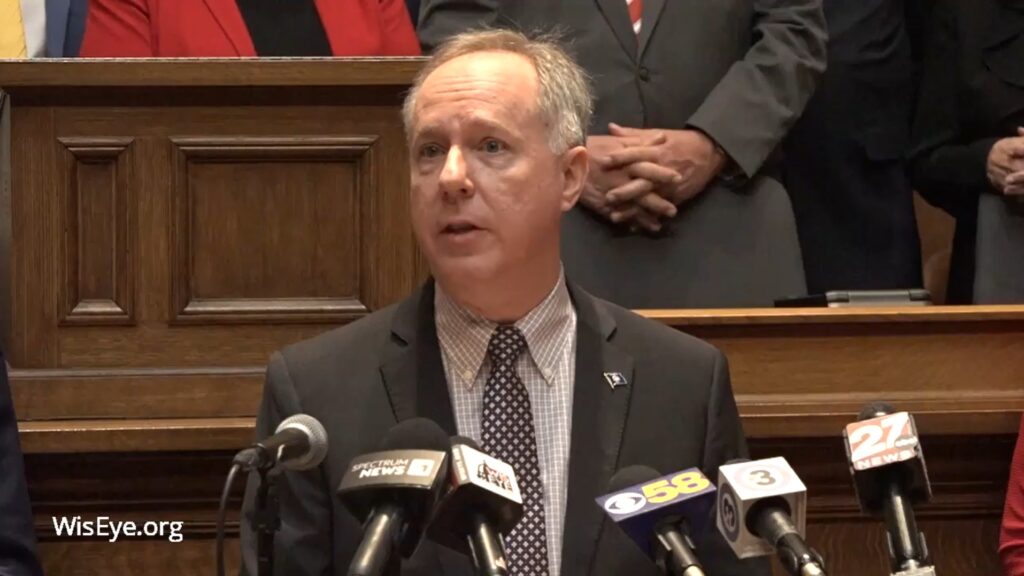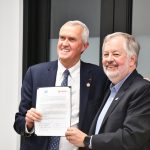Republicans Offer Revised Tax Cut Plan
'Governor, we heard you and we look forward to your signature' on this bill.
Having hit the wall of Gov. Tony Evers’ veto pen repeatedly in the last year when trying to pass multibillion-dollar tax cuts, Republicans in the state Legislature announced one revised and two recycled alternatives Tuesday, urging the governor to sign on this time.
Evers has repeatedly vetoed attempts to cut taxes for people making up to $420,420 a year by eliminating the state’s third income-tax tax bracket. The centerpiece of the GOP proposal Tuesday draws a narrower target: taxpayers with household incomes of up to $150,000 a year.
Another proposal would increase the state’s child care tax credit. That proposal was also part of previous legislation Evers vetoed after it passed the Senate and the Assembly in the fall.
A third measure — also part of previously vetoed legislation — would exempt the first $75,000 in retirement income from the state income tax, or $150,000 for married couples filing jointly.
The fourth provision would raise the tax credit for married couples to offset differences between what individual and married filers pay that lawmakers like to call “the marriage penalty.”
At a brief press conference in the Assembly chamber Tuesday morning, Assembly Speaker Robin Vos (R-Rochester) said that by introducing the measures as individual bills, lawmakers hope to increase the chances that Evers might sign at least one.
“We have tried numerous times to reduce taxes, and unfortunately, we have hit a roadblock many times because we put together a comprehensive package. And Gov. Evers has found something to dislike in almost every one of the ideas that we put forward,” Vos said. “We are actually putting forward a series of individual bills, allowing Gov. Evers to hopefully sign them all. But worst-case scenario, he can pick several out of the categories of tax relief that we’ll see here today, to be able to sign them into law and give the relief that Wisconsinites need.”
If taken together, the proposals would reduce state revenues by $2 billion in the 2024-25 fiscal year and $1.4 billion in each of the fiscal years 2025-26 and 2026-27, according to the Legislative Fiscal Bureau.
Expanding the second tax bracket
The biggest change from past proposals involves the state’s second-lowest tax bracket, 4.4%, for taxpayers with incomes from $14,320 to $28,640 for single filers and $19,090 to $38,190 for married couples filing jointly.
In the 2023-25 budget and again in stand-alone legislation, the Republican majority in the Legislature attempted to eliminate the third bracket: 5.3% on incomes from $28,640 to $315,310 for single filers and $38,190 to $420,420 for joint filers.
Those taxpayers would have been added to the 4.4% bracket under the previous proposals. Democrats and outside analysts criticized that approach because the tax savings were skewed toward taxpayers at the higher end of that range.
The new proposal would cap the 4.4% bracket at $112,500 for single filers and $150,000 for joint filers.
“Under this proposal, the average family making $150,000 a year would experience an $800 per year tax cut,” said Sen. Howard Marklein (R-Spring Green), co-chair of the Legislature’s Joint Finance Committee.
“You think about people making $150,000 on a joint tax return or less — that’s a nurse and a teacher, a construction worker and a cop,” Marklein said. “Gov. Evers has said many times that $150,000 is middle class. Governor, we heard you and we look forward to getting this proposal on your desk for your signature.”
Child care tax credit increase
The child and dependent care tax credit proposal would increase the size of the state income tax credit that Wisconsin residents can get for child and dependent care expenses.
With the federal child and dependent care tax credit, families can offset their tax bill by a percentage of what they pay for child care. The state credit piggybacks on the federal credit.
Currently the state tax credit is 50% of the federal child care tax credit. The Republican bill would raise that to 100% of the federal credit.
Both the state and federal tax credit have a ceiling on the expenses that taxpayers can apply to get the credit: $3,000 for one child or $6,000 for two or more children. The bill would raise the state ceiling to $10,000 for one child and $20,000 for two or more children.
The state and federal credit are both applied to a percentage of those expenses, determined on a sliding scale. Households with an annual income of $15,000 or less can claim 35% of their child care expenses. The percentage drops as income goes up. Households with incomes of $43,000 or more can claim 20% of those expenses. There’s no cap on income to qualify for the credit.
Currently a hypothetical family eligible for the federal credit for 20% of their child care costs can get a maximum state income tax credit of $300 for one child or dependent and $600 for two or more children or dependents, fiscal bureau analyst Sean Moran told the Wisconsin Examiner. Under the proposed change, that would increase to a credit of up to $2,000 for one child and $4,000 for two or more children.
“This is huge when it comes to our families,” said Rep. Amy Binsfeld (R-Sheboygan). “If we look at this package as a whole, we see true benefits to families. But even individually, here, we can see [a savings of] maybe $650 per family, maybe a little bit more.”
Easing ‘marriage penalty’ and a retirement income tax break
Wisconsin gives married couples filing a joint return a tax credit for 3% of the lower-wage partner’s income, up to $480. The Republican proposal to increase that to $870 “is just the inflationary adjustment from the $480 that was set in 2001,” said Sen. Joan Ballweg (R-Markesan).
The Fiscal Bureau has projected that 476,460 tax filers would benefit, with an average savings of $338 — putting “more money back into the pockets of our young families.”
With the proposal to waive state income taxes on the first $75,000 in retirement income per person 65 or older or $150,000 per couple, Vos said lawmakers want to encourage more Wisconsin seniors to make the state their primary residence instead of opting for Florida, Arizona or other climes.
“It’s really important that we think about retirees,” said Vos. “There’s nothing we can do about the weather, but the decision of where to reside for six months and a day is very much on the mind of retirees.”
Lawmakers have cited six months and one day as the legal threshold used to establish a person’s primary residence under state tax laws.
“The average filer would save about $1,600,” Vos said. “That’s real money that would help to convince people that you can go to Florida for four months, you don’t need to go for six months and a day.”
According to a Legislative Fiscal Bureau analysis on how the retirement income tax break is distributed across income groups, an average savings of $1,610 would apply to taxpayers with incomes between $200,000 and $250,000. Retired taxpayers with incomes between $90,000 and $100,000 would save on average about $890, according to the chart.
Uneven savings
Despite the proposal’s framing as aimed squarely at the middle class, Legislative Fiscal Bureau calculations show that more than 66% of the combined savings from all the changes in the package go to households with incomes of $100,000 or more. As a group they account for about 20% of all income tax filers in the state.
“There’s a jarring disconnect here between the reality of Wisconsin’s tax structure and the design of these tax cuts,” said Carl Davis, research director at the Institute on Taxation and Economic Policy, a nonprofit think tank in Washington, D.C. When all taxes, including sales, property and excise taxes, are included, “Low- and moderate-income families are paying higher state and local tax rates in Wisconsin than any other group, and there’s next to nothing in this package designed to benefit them,” he added.
An ITEP report published earlier this month found that Wisconsin taxpayers who are in the bottom 20% by income pay about 10.8% of their income on state and local taxes. The top 1% of Wisconsin households pay 6.6% of their incomes in taxes, and middle-income taxpayers pay 9.9%, the report found.
In a report published in March 2023, ITEP also looked skeptically on tax breaks for seniors, finding senior migration rare and little evidence that it was driven by tax policy. “Given how rarely seniors relocate across state borders, the vast majority of senior tax subsidies are inevitably a windfall to people who would have been living in the state anyway, rather than a genuine behavior-shaping incentive,” the report said.
The Fiscal Bureau’s analysis of the child care tax credit increase shows that filers in the $100,000-or-more range will account for 65% of taxpayers who make use of the credit and get more than 75% of the resulting tax savings.
“Child care affordability is a huge problem for a lot of families right now, but this isn’t a targeted way to improve affordability,” Davis said. “This isn’t how you’d go about structuring a reform if your top concern is really the folks who are most struggling to afford care.”
The child care tax credit is nonrefundable — which limits the actual benefit taxpayers receive to the amount they owe in taxes. That can end up leading some taxpayers with lower incomes to pay more out of pocket than taxpayers whose incomes — and tax bills — are high enough that they get the full value of the tax credit.
“It would be very easy to structure a tax cut so that more of it goes to folks with moderate incomes who are currently paying high overall tax rates,” Davis said. One approach would be to make the child tax credit refundable, he said: Taxpayers who qualified for a credit that was more than their total state income tax bill would get the difference back in cash.
He suggested expanding Wisconsin’s earned income tax credit or homestead tax credit as other options.
“Income tax rate cuts and nonrefundable tax credits just aren’t geared toward folks with moderate incomes, who tend to pay more through the sales and property tax than they do through the income tax,” Davis said.
Republicans roll out $2B tax cut package, telling Evers ‘we heard you’ was originally published by Wisconsin Examiner.























